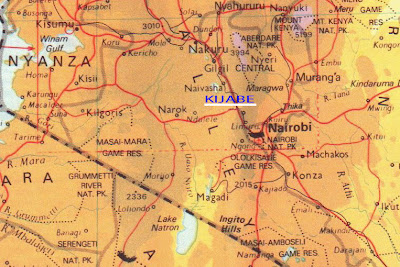Since then we have corresponded. She got married in 2007 to Daniel who is a
Luo. The social difference between the
two tribes was imperceptible until the election troubles of 2007. The troubles went from election controversies
to property violence to murder and then to parliamentary shenanigans since
then. The recent elections earlier this
year have finally ended the strife.
Daniel was a district nurse at Naivasha, a town in the GRV north and
west of here, when the two first got married.
He now works in Nairobi with an AIDS program funded by the University of
Maryland. They had planned to be married
when the troubles started. Anne was in
legitimate danger as she lived “outside the wall,” but on hospital
grounds. Anne’s pastor had urged Anne
and Daniel to delay the ceremony because “it was no time for you two to be
married.” Anne and Daniel countered that
it was, in fact, the best time to be married…and did.
They have two children:
Favor, 3, and Felix, 9 months. We
spent an enjoyable evening talking politics (Kenyan and American), gas prices,
soccer matches and religion while, with infinite patience, Favor’s braids were
undone and Felix’s explorations of the mysteries of cruising around a coffee
table were observed. Anne is now the “matron”
(read hospital administrator) for the Bethany Kids- Kijabe Hospital, the
pediatric ward of the hospital.
We had lamb stew with rice and chapatti (Indian flat bread
which has been adopted by Kenya enthusiastically). Dinner was finished with a glass of hot
water. I walked back from their cottage
with the hadadas crying in the trees.
It had taken me a while to identify the owners of the cry: a
cross between the croak of a crow and the quack of a large duck. To my surprise, the calls belonged to a flock
of scimitar-beaked, goose-sized, short-legged ibis, the hadada, who, despite
their appearance, roost in the foliage of trees. Their cry is supposed to be “haaadaadaah.” Were it me, I would not call attention to my
deficiencies of grace and beauty.
I attended staff prayers on schedule and we sang a cappella “What a friend we have in
Jesus,” the small group of Kenyans and Westerners mingling their voices in the
music of that old good song. We shared
the deaths of patients.
“All our sins and
griefs to bear”
I prayed with Elinor, a Kenyan nurse, for the hopes of a new
academic year and completion of her master’s degree.
“What a privilege to
carry
everything to God in prayer”
I suppose I can share a few words about my living
arrangements. I live in Heron House (all
of the cottages have bird names with the exception of Pathology House). It is the designated “boy’s house” and I
share it with 3 other docs currently.
One is Matt who is a visiting radiologist from Birmingham. The hospital has a CT scanner and the films
done are generally excellent. Shawn is a
Christian, born in Goa, India, raised in Nairobi and currently a Pediatrics resident
at Agha Kahn Hospital, the premier private hospital in the country. He is doing a rotation in Pediatric Surgery
here and for the first two weeks I thought he was a mirage, rising before the dawn
and not coming back until I had turned in.
His initial take on Kijabe is the major alteration in work ethic. He reported that he was floored when he came
onto a ward to find a visiting American doc waiting patiently for a patient to
arrive. Private docs wait to be called
at home in Kenya. Prayer before rounds and
surgery is a delight for him.
The last housemate is “The Great Oohmmz.” Omar is one of ten children of a Muslim
family and will be entering the government Neuro-Surgery Program next month when
he returns to Nairobi. He is tall,
painfully thin, opinionated, gracious and garrulous. He speaks with authority about most any
subject and has the fine grace to make jokes at my expense as I do at his. All
food found on the counter is free-range.
Food in the cupboards is safe from predation.
My own health is not as good as it could be as I got a cold
and it has caused a flare in my respiratory problems. I am better but my voice is a croak and I
talk all day to its detriment.
The nursery is relatively light but hot (88 F and 60%
humidity) and in consequence, wearing. A
baby born 3 weeks ago weighing about 2.5 lbs. with moderately bad lung disease
had an initial rocky course. Her lung
disease resolved and she was finally on her upward leg with weight gain and good
feedings. Today she suffered a setback
and is on a ventilator. Please pray for
Grace’s baby girl.
“Carry everything to
God in Prayer.”










